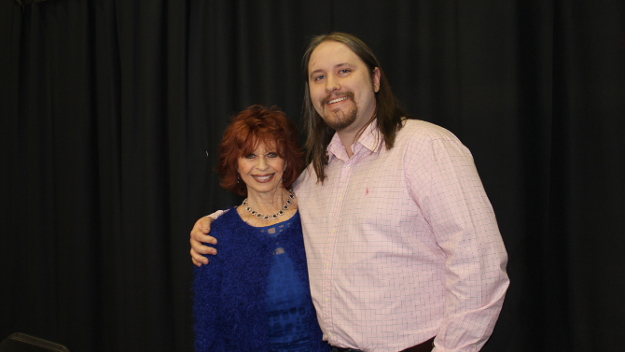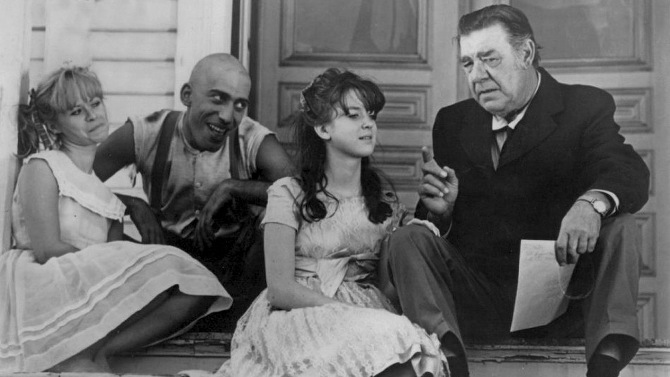Though I consider myself well versed in most areas of film, I must say that I knew nothing about the horror cult classic Spider Baby or, The Maddest Story Ever Told, until I began researching for my interview with Beverly Washburn, who starred in this quirky motion picture that was filmed in 1964, though it was only released in 1967 (due to issues with finances and poor distribution).
Filmed on a shoestring budget and starring Lon Chaney Jr., this black and white flick utilizes every horror stereotype, yet in a fun and interesting way, to make a movie that feels more than influential. It has a secluded manor home on a hill (Psycho), a creaky gate, a loyal servant who follows the rules of his dead master and takes care of his family (Renfield), a line of kin who, affected by inbreeding, are crumbling from within (Fall of the House of Usher), as well as visitors that enter the dangerous and unfriendly abode (feels like almost every horror flick) – making for a California gothic tale that features both quirky 1960’s horror as well as veins of comedy running throughout.
The motion picture opens with a kooky theme song sung by star Lon Chaney Jr. The off kilter tale then begins with one of our soon-to-be main characters picking up a book entitled ‘Dictionary of Rare and Peculiar Diseases’ and reading that the Merrye Syndrome is, “so called because its only known occurrence is among the descendants of one Ebenezer Merrye; a progressive age regression beginning about the tenth year and continuing steadily throughout the victim’s lifetime. It is believed that eventually the victim of the Merrye Syndrome may even regress beyond the prenatal level, reverting to a pre-human condition of savagery and cannibalism. Many authorities do not accept the existence of the Merrye Syndrome.” The man reading is Peter Howe (Quinn K. Redeker), and it is his memories that we experience at the decaying country estate mentioned above. Before I continue, I must say that I dug this opening. The retelling of a life’s story as a film device can be an iffy thing, but the description of the malady sets the tone, while our return to the narrator’s abode at the conclusion of the picture leaves us with a fitting ending to the film.
Chaney plays Bruno, a loyal servant of the wealthy yet inflicted Merrye family. He is both chauffeur and caretaker for the three remaining descendants of the lineage (who are already suffering from symptoms of the mental abnormality): the seemingly prim and proper Elizabeth (Beverly Washburn), the murderous wild child Virginia (Jill Banner) and the nearly infantile Ralph (horror icon Sid Haig).
While Bruno is away, a letter is delivered by a messenger, played by iconic character actor Mantan Moreland, explaining that the Merrye family will be visited by two distant relatives as well as a lawyer and his secretary, to deal with the estate of the deceased patriarch. The first two to arrive are the snooty and unfriendly Emily Howe (Carol Ohmart) and her easygoing, happy-go-lucky brother Peter (who introduced us to this tale at the beginning of the picture) – the distant relatives of the reclusive clan. Soon after, Bruno picks up the aptly named Mr. Schlocker (Karl Schanzer) and his kind secretary, Ann Morris (Mary Mitchel), escorting them into the slovenly, crumbling yet historic mansion where they meet the family.
The guests are clearly angling for a payday and seem unwilling to leave the locale. Despite Bruno’s forcefully implied suggestion that the group depart, they insist on staying for dinner and vigorously persist in their right to spend the night.
The caretaker does his best to prepare supper for the crowd, cooking meat for the first time in ages (it is said to increase the rate at which the children’s disease progresses). This is one of the standout scenes, as the mix of varied characters, the more than unusual food, and the interactions amongst those at the table are highly enjoyable. For true horror fans, there is a point where the conversation turns to horror flicks, and Peter and Ann begin to discuss classic movie monsters. A little known fact is that Chaney was the only actor to don each of the famed Universal monster suits (Dracula, Frankenstein, The Mummy, and of course, The Wolf Man – which he originated). When the conversation finally turns to the hairy creature, Chaney’s reaction is priceless, with his face changing and him masterfully uttering “there’s going to be a full moon tonight”. For that single moment, we feel like he is back in that legendary role.
I must also mention a piece of dialogue that comes later in the film, when Peter is driving Ann to a motel as there is not enough room in the home for all of the guests. Both a bit tipsy, they once again return to the topic of classic horror films, with the beau asking Ann, “Hey, are you really a wolf fan, Wolf Man, fan, Ann?”. The dame proclaims, “Oh, yes! I think that is how every man should be, like a wild beast”. This utterly kitschy dialogue captures some of the zany fun of the piece, yet it also harkened me back to one of my favourite horror comedies, Abbott and Costello Meet Frankenstein, when nearly twenty years earlier Lon Chaney Jr. (playing Wolf Man Lawrence Talbot) tells Bud Abbott and Lou Costello’s characters, “I know you’ll think I’m crazy, but. . . in a half-an-hour the moon will rise and I’ll turn into a wolf”, and Costello’s Wilbur dryly retorts, “you and 20 million other guys!”.
Horror is often at its best when it realizes that the scenario it is depicting is funny in a weird way. Spider Baby hits this vibe right on the mark. Writer/director Jack Hill was able to create a motion picture that is both spooky and humourous. He and his team shot a simple yet effective film that uses its shadowy black and white colour to perfection – always placing the camera in the exact spot to evoke the right mood at every twist and turn. He plays with his audience, providing us with knowledge that certain characters do not have and then teases us as we watch something that may or may not, in the end, happen. Today, its rather disturbing topics of cannibalism, murder and insanity would likely translate to a gory slasher flick with little nuance, but a mix of sixties’ culture and Hill’s deft touch serve to create a film that is easily palatable to all viewers. There is a reason why filmmakers like Quentin Tarantino, Joe Dante, and Rob Zombie love this rather ‘out there’ flick.

Actress Beverly Washburn, who plays Elizabeth Merrye in Spider Baby, with Filmizon.com’s Nikolai Adams at CAPE Cornwall 2016
Another one of the things that makes Spider Baby stick out is the more than entertaining cast. Lon Chaney Jr. was always able to evoke a powerful emotion from his audience, as there is a perpetually deep sadness or mysterious pain flowing beneath the surface. He creates a wonderful role that shows a man who is struggling to deal with an impossible situation, yet despite the malady of the children, he oozes unconditional love to the misguided youths. Beverly Washburn is superb as the ‘more mature’ Elizabeth, capturing the child-like attitude of a goody-two-shoes – though, at times, is far from it. Jill Banner is spooky as the wide-eyed child who loves to play her macabre spider game. Sid Haig is priceless as an utterly goofy, drooling man-child who is the most far gone of the three. . . and for this reason, perhaps more dangerous than the other two. Karl Schanzer is excellent as the trashy weasel of a lawyer and Carol Ohmart’s unlikable relative is somewhat similar to the attorney, capturing a cruel and uncaring attitude toward her distant family members. Quinn K. Redeker is a great counterpunch to the above two, concocting an easygoing, cheerful individual who sees everything with rose coloured glasses, while Mary Mitchel’s portrayal of the secretary echoes this sentiment. Throughout the film, the cast’s subtle movements and unique facial expressions stand out.
Ronald Stein’s composition also adds dimension to the picture. His orchestral score is pure horror gold, with motifs that often spiral downwards, capturing the film’s theme of a descent into madness. Plus, there is an interesting touch of sixties era pop music that seeps in sporadically, making it true to the time.
Spider Baby is a movie that most likely should have never been. Made with nearly no money, it should not have been able to boast such a great cast that was led by Lon Chaney Jr. (who was paid a measly 2500 dollars for the role – the other actors were paid 100 dollars a day for the twelve day shoot). It had a carousel-like rotation of different titles, starting with “Cannibal Orgy”, then moving to Spider Baby, finally ending in 1968 with “The Liver Eaters” or “Attack of The Liver Eaters”. It never had a premiere, as the film’s producers went bankrupt in 1964, leaving it in limbo for nearly four years. When it finally was procured by another producer, it had a small release that flailed due to poor marketing. Yet, in true cult classic nature, it has survived. It never disappeared into nothingness and has thrived into the twenty-first century, growing a solid fan base.
Also, make sure to check out my interview with Beverly Washburn down below to hear some great tales about The Maddest Story Ever Told. In the end, you’d be mad to turn down watching this cult classic – its dynamite!


This movie is definitely weird. I can see why it’s a cult classic.